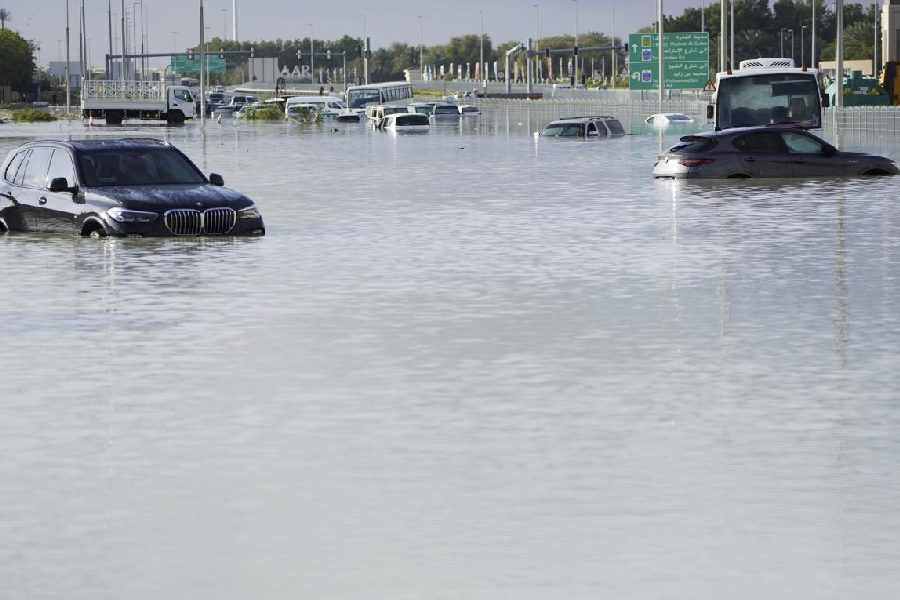Rainfall events in El Nino years, such as the recent one that impacted the UAE and Oman, have become 10-40 per cent heavier in this region of the Arabian Peninsula, according to a rapid study by an international team of leading climate scientists.
While the researchers from the World Weather Attribution group could not precisely determine the exact contribution of human-caused climate change to this increase, they said warming caused by burning fossil fuels is likely the primary driver behind the escalating rainfall.
Friederike Otto, senior lecturer in Climate Science at the Grantham Institute - Climate Change and the Environment, Imperial College, London, said both El Nino and human-caused climate change seem to be influencing heavy rainfall in the UAE and Oman.
El Nino refers to unusual warming of surface waters in the central and eastern Pacific Ocean and is associated with heavier rainfall in many regions of the world.
"While we cannot control El Nino, we have the power to curb climate change. The solution lies in halting the burning of fossil fuels and deforestation," she said.
Mariam Zachariah, researcher at the Grantham Institute - Climate Change and the Environment, said the finding is not surprising and agrees with the basic physics that a warmer atmosphere can hold more moisture.
"Model uncertainties meant we could not complete the last step of the analysis to precisely quantify how much of the increasing rainfall is due to climate change. However, multiple lines of evidence point to climate change as the most likely explanation for the increasing rainfall," she said.
On April 14-15, extreme rainfall battered regions of the Arabian Peninsula. Dubai experienced more than 14 cm of rainfall in 24 hours, equivalent to a year and a half of typical rain and the heaviest on record since 1949.
Flash flooding claimed 19 lives in Oman, including 10 children in a tragic school bus accident, while four fatalities occurred in flooded cars in the UAE.
The flooding wreaked havoc, causing extensive damage to infrastructure, power outages and disruptions to daily life. Dubai airport, the world's busiest international airport, faced significant delays and cancellations due to flooded runways.
The Arabian Peninsula experiences infrequent spells of short, intense rainfall. The heaviest rain usually occurs in March and April and are typically driven by mesoscale convective systems that form when several thunderstorms come together.
The researchers, including scientists from universities, research organisations and meteorological agencies in Saudi Arabia, Switzerland, Sweden, the Netherlands, Germany, the UK and the US, analysed weather data and climate models to quantify the effect of human-caused warming on the extreme rainfall in the Arabian Peninsula.
The analysis looked at the maximum one-day rainfall and focused on the UAE and Oman.
Heavy rainfall events in El Nino years have become 10-40 per cent heavier in the region, the scientists said, citing historical weather data.
The large range in this increase is due to the huge variability in the data as the UAE and Oman often go months without rain and, in the historical record, there are only a small number of extreme rainfall episodes, they said.
The observations also indicate that El Nino plays an important role in the likelihood of heavy rain episodes in this part of the world, as the heaviest rainfall events in the region all occurred during El Nino years.
To investigate if climate change is driving this increase in rainfall, the researchers combined these historical observations with climate models.
However, most of the models analysed did not show a strong influence of global warming on heavy one-day rainfall events in the region. But again, the scattered and sparse nature of the rainfall limits the researchers' confidence in these results.
While the study could not precisely quantify how much of the increased rainfall is due to climate change, the scientists say global warming is the most likely explanation for several reasons.
First, a warmer atmosphere can hold more moisture, with the Clausius–Clapeyron relation indicating that at 1.2 degrees Celsius of global warming, the atmosphere can hold about 8.4 per cent more moisture. In addition, changing circulation patterns driven by global warming can further increase the intensity of rainfall in particular regions.
Flash flooding is common on the Arabian Peninsula, particularly in river valleys, but also in cities. In Oman and the UAE, 80 per cent and 85 per cent of people, respectively, live in flood-prone and low-lying areas.
Though meteorological agencies accurately forecast the heavy rainfall, the high casualty toll suggests that the warnings may not have effectively reached everyone or sufficiently conveyed the potential risks.
The study did not explore the impact of cloud seeding on rainfall.
Despite routine cloud seeding efforts in the UAE, the magnitude of the recent storm system indicates that massive rainfall would have occurred regardless of seeding operations, the researchers said.
Except for the headline, this story has not been edited by The Telegraph Online staff and has been published from a syndicated feed.










